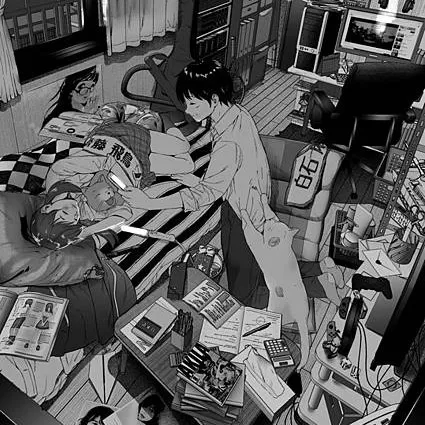"Hentai Manga using filmmaking techniques."
Today, I'd like to introduce a very unique topic: "Hentai Manga using filmmaking techniques."
I wonder if you all like watching movies or not? Personally, I really enjoy it and can watch three to four times a week. The most fascinating aspect of movies is that they are a form of visual art crafted by various cinematic techniques, including cinematography, actors, editing, lighting, and more.
The serialized mangas we are familiar with today are, in fact, deeply influenced by filmmaking techniques. To borrow a phrase from director Niney, describing mangas as a "movie theater on paper" is not an exaggeration at all.
So, what are the film techniques that can make our readers feel like they're watching an action-packed sex movie while reading Hentai manga? Let's use these four manga to give you a brief introduction!
Technique One: Long Take
Sample Manga:[Circle Eden (ヂイスケ)] 中出し放題孕ませヤリ部屋ハーレム
(Kouroumu 15) [Circle Eden (Diisuke)] Nakadashi Houdai Haramase Yaribeya Harem
KM216002
A "long take" is a filming technique where a single shot is captured continuously for an extended period without switching camera angles. There is no specific duration that defines a long take; it simply aims to meticulously showcase every detail of a particular event or scene from start to finish.
Some films even consist entirely of long takes, for example, the 2014 American movie "Birdman." The entire movie, with a runtime of over a hundred minutes, follows the camera as it trails behind the male protagonist, an actor in a stage play, showing how he navigates the backstage chaos.

In this manga, the male protagonist and the female protagonist are locked in a small dark room with a spell, and they cannot get out unless they climax more than 500 times. So they could only eat, drink, have sex and have sex in this cramped room. The painting method uses the long lens technique:

These divisions are very coherent and very real. After a woman has sex, she has to rest and catch her breath, she needs to pee so she goes to pee, and she watches the person next to her having foreplay. Each character presents the trivial things they have to do, unlike many porn mangas that only retain the process of having sex.

Staying in a distant position keeps everyone from "leaving" the reader's gaze, making everything one does visible.
These trivial matters other than the sexual intercourse scenes are redundant, but they also give people a more immersive feeling, allowing them to experience the real flow of time in the play, thereby enhancing the sense of reality.
This is one of the most commonly used film techniques in hentai manga. For example, Shindo Eru is very good at using it, but the camera changes more frequently.
Technique Two: Flashback
Sample Manga:[絶対少女]泥棒猫の横恋慕 (C80) [Zettai Shoujo (RAITA)] Dorobouneko no Yokorenbo (Bakemonogatari)
KM301041
"Flashback," a term you may be unfamiliar with, but you've undoubtedly seen it in movies and television shows: the protagonist suddenly remembers something that happened in the past, lowers their head in contemplation, and the next moment, the scene shifts to their younger self doing the thing they just recollected.
This is called a flashback. The specific definition is: using editing techniques to take the story from the current time in the narrative back to the past, allowing the audience to understand.
This technique is ubiquitous in many suspenseful films, particularly in suspense and detective genres. The director "maestro" Christopher Nolan employed it in his 2001 self-directed and self-written film "Memento," which begins with a man losing his memory. Every time he recalls his past, there are flashbacks, with dozens of different times and locations in these flashbacks. Some of them are even figments of the protagonist's imagination, providing a significant challenge for the audience's deductive reasoning.

This manga fully utilizes flashbacks to add layers of complexity to what would otherwise be a mundane extramarital affair storyline.
A woman came to a man's house at three in the morning, lay naked on top of him, took out his dick, licked it seductively, and murmured to herself.

As she murmured, the scene began to flash back, and the full story of the matter gradually unfolded in front of the reader. It turns out that this virgin man and his friend, who is also a virgin, made an agreement not to masturbate before the next date, hoping to give each other the best experience of losing their virginity. And the woman who had a crush on him silently observed all this during the day and seduced him intentionally or unintentionally (Stealing Cat www)
Flashbacks gradually change. Sometimes the woman's recollections are of things that really happened, sometimes of her imagination, and sometimes of repressed erotic dreams... The flashbacks wander among the true and the false, and the cock that continues to thrust in and out is the only thing that interrupts the flashbacks reality.

The sex scene ended with the ejaculation of semen. Time returns to reality. The man who didn't know anything about it went to make an appointment with his girlfriend, but his girlfriend's expression seemed to have guessed what was going on.

The end of blood is inevitable (shaking)
Technique Three: Close-up
Sample manga:[じょろり] 記念日 [Jorori] Kinenbi. | Anniversary.
KM216490
Close-up, I'm sure everyone is familiar with this. The choice of angle, lighting, camera distance, and position to compose an image can determine how you perceive the subject. For example, when a person has a car accident on the road and is bleeding, filming with a close-up on the injured person's face will make you feel their pain. On the other hand, if you zoom out to capture the entire road, it will draw your attention to the real reactions of passersby, whether they are just bystanders or genuinely helping with the incident.
In film, close-up shots are often closely intertwined with framing and editing to achieve the effect of montage. The anime director Makoto Shinkai is particularly skilled at utilizing close-ups. In his 2007 work "5 Centimeters Per Second" (秒速5センチメートル), he beautifully juxtaposes cherry blossoms and the silhouette of a young man, as if conveying that this individual is so out of place. The sorrow of heartbreak turns every scenic beauty into a piercing irony.

The author Jorori, whom we have introduced in a previous article, is known for his expertise in pure love stories.
He is also one of the authors who is most familiar with the concept of close-up in the world. When many colleagues' storyboarding methods for pornographic mangas only stop at two things: "very big breast woman" (first-person close-up) and "dispensable passerby" (just draw a few frames on the background) At the same time, he was meticulous and fully described every scene and every frame:

The man's penetration, the woman's gentle removal of the condom, the flash of the wedding ring, the letter "I want to increase my family" written on the bottom of the condom, the girl's beautiful voice after being penetrated...
There are five grids in a row, and the three objects in the middle seem to have nothing to do with sex but are just backgrounds. However, the continuous close-ups of these three groups of objects fully demonstrate the girl's determination before having sex, the initiative represented by her fingers, and the use of The montage method suggests that the thoughts that flashed through the heroine's mind when the boy penetrated her were not pleasure but marriage.
This can be considered textbook-level sequential storyboarding. Jorori has also created numerous sequential illustrations on Pixiv, each consisting of only a few pages, yet they clearly showcase his understanding of film storytelling and the concept of close-ups, as seen in this example.




Clearly, his ability to use long shots is also at a certain level. In the world of cinema, the proximity of a close-up is indeed closely tied to the duration of the camera shot. This leads us to our fourth technique: mise en scène.
Technique Four: Mise en scène
Sample manga:[チョットだけアルヨ。 (竹村雪秀)] 暑い日だらだら (アイドルマスター)
KM301163
Mise en scène is one of the most closely related and yet most challenging techniques in the realm of filmmaking, as it pertains to the story script. Typically, only the director can handle this aspect of the process.
The specific meaning of mise en scène is the arrangement of everything that appears in a film - actors, sets, props, costumes, and lighting - how they come together, how they move, in what way they move, where they move, and when they don't move. It encompasses all the techniques related to movement in a film.
Just by listening, you can tell how difficult this is. No matter how talented the actors and how good the special effects are, if the mise en scène isn't done well, it's all in vain. For example, in the war film "Midway" released in November this year, the director had to coordinate dozens of aircraft and hundreds or even thousands of actors to recreate the battlefield scenes of World War II. Just thinking about commanding so many elements can make your head spin!

However, effective mise en scène can bring everything to life and make it vibrant.
Takehiko Inoue is a manga artist who excels in mise en scène within the manga world. Although manga doesn't involve actual movement, he always manages to imbue the characters with vivid, versatile body language, creating a level of narrative depth that eludes many illustrators who can only depict a few basic poses, no matter how beautiful their artwork may be.

The rural crossbreeding trip between two women and one man was so hot that they lost their humanity. Such a strange narrative has been transformed into strange scenes in Takemura's writing that most pornographic mangas authors can't even imagine: a woman whose whole body is covered in sticky sweat and doesn't want to move like a dead fish, and a woman who is so hot that she can't ejaculate and has to wipe it. The man who rubs his dick, the child who gets something to eat during threesomes.

Looking at this classic scene, the two girls Ssangyong, who were originally infinitely lustful, turned out to be a little painful and a little hot at the same time, while the boy watching picked up a beer and drank it. It was a weird and somewhat manga scene.
The techniques of mise en scène are challenging to describe purely through text because it's not like camera shots or editing where there are specific frames to indicate mise en scène. However, mise en scène is everywhere in film and can transform a series of shots and edits into a fresh and powerful continuous story. This is the essence of effective mise en scène.
This manga is like that. It is an ordinary story and a painting style that is not particularly sensational, but through a series of combinations, it brings a sweltering summer to life, vividly and vividly, making people feel it. When three people are so tired from having sex that they fall asleep, one of them is still holding his dick, which makes people laugh knowingly.

That's all for today's introduction. This time, the topic has gotten a bit more in-depth. I wonder if everyone likes this style or not? In any case, feel free to share your opinions with us. 18Article, see you in the next issue~




















